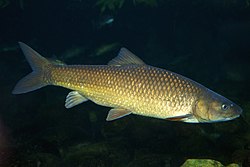| Labeobarbus | |
|---|---|
 | |
| Clanwilliam yellowfish (Labeobarbus seeberi) | |
| Scientific classification | |
| Domain: | Eukaryota |
| Kingdom: | Animalia |
| Phylum: | Chordata |
| Class: | Actinopterygii |
| Order: | Cypriniformes |
| Family: | Cyprinidae |
| Subfamily: | Torinae |
| Genus: | Labeobarbus Rüppell, 1835 [1] |
| Type species | |
| Labeobarbus nedgia Rüppell, 1835 [1] | |
| Diversity | |
| See text | |
| Synonyms [1] | |
Labeobarbus is a mid-sized ray-finned fish genus in the family Cyprinidae. Its species are widely distributed throughout eastern Africa and especially southern Africa, but also in Lake Tana in Ethiopia. A common name, in particular for the southern species, is yellowfish. The scientific name refers to the fact that these large barbs recall the fairly closely related "carps" in the genus Labeo in size and shape. As far as can be told, all Labeobarbus species are hexaploid. [2] One species, L. microbarbis from Rwanda, is known to have gone extinct in recent times.